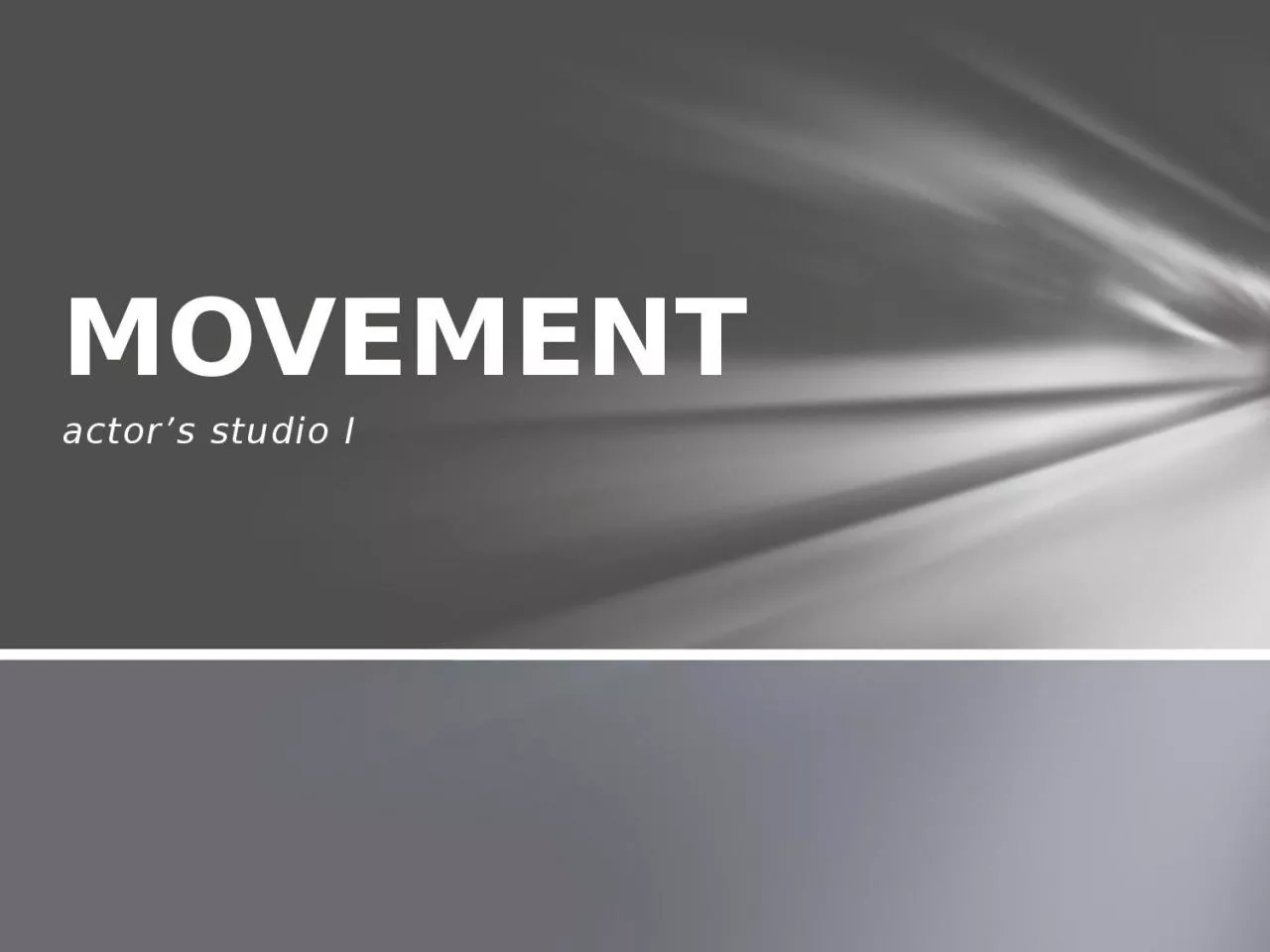

TYPES OF STAGES STAGE DIRECTIONS BODY POSITIONS PRINCIPLES OF MOVEMENT BLOCKING STAGE COMPOSITION CHARACTER MOVEMENT MOVEMENT PROSCENIUM THRUST ARENA TYPES OF STAGES PROSCENIUM Proscenium Stage ID: 1030734
Download Presentation The PPT/PDF document "a ctor’s studio I MOVEMENT" is the property of its rightful owner. Permission is granted to download and print the materials on this web site for personal, non-commercial use only, and to display it on your personal computer provided you do not modify the materials and that you retain all copyright notices contained in the materials. By downloading content from our website, you accept the terms of this agreement.
1. actor’s studio IMOVEMENT
2. TYPES OF STAGESSTAGE DIRECTIONSBODY POSITIONSPRINCIPLES OF MOVEMENTBLOCKINGSTAGE COMPOSITIONCHARACTER MOVEMENTMOVEMENT
3. PROSCENIUMTHRUSTARENATYPES OF STAGES
4. PROSCENIUM
5. Proscenium StageAPRONPROSCENIUM ARCHAUDIENCE
6. THRUST
7. THRUST STAGE
8. ARENA “theatre in the round”flexible seating
9. ARENA STAGE
10. STAGE DIRECTIONSproscenium & thrust stage onlyStrongest area
11. STAGE DIRECTIONSarena staging onlycenterNorth/12:00South/6:00East 3:00West 9:00#1#2#2#2#2
12. BODY POSITIONSFF-important lines¼ - most dialogue scenesProfile: intense scenes such as quarreling, accusing, romancing, etc. used to obtain comic effectsFB – used in special occasions
13. Identify the body positions…The Prime of Miss Jean Brodie
14. 1. All movement MUST be motivated or justified. NO shuffling your feet, fidgeting, or nervously moving. An actor should never move without a purpose.2. All movement must be simplified. Use carefully chosen movement that clearly conveys your ideas.3.All movement must be heightened. Due to the distance between the actor & audience some exaggeration or heightening is necessary. Ex: drawing special attention to an object . For example, the hiding of a letter in Act I that must later be found in act IIIPRINCIPLES OF MOVEMENT
15. 4. Movement must reveal character. A character’s personality, attitude, health & age SHOWS movementFat person vs. thin person; easy-going person vs. nervous person; Youth’s actions vs. older people. Always move in character!5. Movement must be “open” to the audience Always play toward the “house.” Use a one quarter body positionMake turns toward the audienceUse you upstage hand so you can “open” your face to the audience. PRINCIPLES OF MOVEMENT
16. 6. Movement must adjust to the characters on stage.Keep in mind your relationship to the other characters.People who dislike each other generally keep at a distanceThose fond of each other will feel the need of closenessPRINCIPLES OF MOVEMENT
17. BLOCKING NOTATIONSEN – enter (to come in)EX – exit (to leave)X – to cross (or move from 1 stage area to another)CX – counter cross (move away)A – above (upstage of object)B – below (downstage of object)O – open up or “cheat out” (turn body, face to audience)BLOCKINGThe precise movement and positioning of an actor on a stage
18. 1. DR 1/4L2. X UC-FF3. X UR-1/4L4. X C-PRL5. X DL-3/4R6. X UL-FFBLOCKING NOTATIONS
19. 1. Avoid “flat” blocking. Use angles & diagonals; looks more dynamic2. Use triangles. Creates goods composition instantly with actors and in relation to set choices3. Make crosses downstage from furniture and actorsScenes behind furniture feels distant & unrealistic4. Block shared scenes on the same planeOtherwise you will be upstaging RULES WHEN BLOCKING
20. 5. Avoid “over blocking”Constant moment doesn’t carry much meaning you just look busy and it doesn’t show characterShow the meaning behind the line and show thatALL MOVT. MUST BE MOTIVATED6. Create build with blocking. Work to show the build in the scene, don’t start out in other’s faces in a stand offRULES WHEN BLOCKING
21. 1. Work through the practical blockingentrances, exits answer phone, turn light on/off Playwright’s notesDon’t follow what’s written look to dialogue – add your own!BLOCKING RHEARSALS
22. 2. Look at the basic blocking patternsDetermine the climax and work towards itEx: love scene (start far apart and then get closer together) = physically shows the build *climax* of the sceneUse the character’s objective, obstacle & tactic to help you make blocking choicesAs the beat changes, logically this could be a good be time to move as well. (transition in thought) BLOCKING RHEARSALS
23. FURNITURE PLACEMENTAngle furniture piecesStraight lines look flatLimit pieces to go against a walllimits blocking Action’s played in front Looks flatKeep distance between furniture pieces Need room for movement patterns between piecesWait Until Dark
24. The Mousetrap
25. Fox On The Fairway
26. FLOOR PLANFront doorBath roomDeskWindowsXStraight cross shortest, most direct routeStrength, decisiveness & determination Curved cross indecision, casualness, grace, or easeA bird’s eye view of the set, drawn to scale, showing placement of set pieces & furniture
27. STAGE COMPOSTIONLEVELSsit, kneel, stand, lie downShow power; social statusBALANCECreate balance; counter crossingGenerally, standing in straight lines is a no-noLaughter On The 23rd FloorA Little Night Music
28. Composition http://youtu.be/EbGOdGUsslQSTAGE COMPOSITIONDEPTHUse of trianglesGroupingsDifferent planesFOCUSDirect audience’s attention How To Succeed In BusinessThe Diary of Anne Frank
29. When an actor adds DETAILED, physical action, which furthers the character’s believability and realismMannerismsStage BusinessGesturesCHARACTER MOVEMENT
30. MANNERISMSHabits of the character without a propEx: bouncing leg, twirling hair, cracking knucklesSTAGE BUSINNESSHabits of the character with a propEx: smoking, tapping a pencil, popping chewing gumGUESTURESusing hand, arm, body, head or face movements to express thought or emotionEx: wave good bye or come here; frown, stick out tongueCHARACTER MOVEMENT
31. Identify the gesture, mannerism or stage business…
32. WEIGHTHow light or heavy the character is on their feet; not the physical weight of the characterTIMEThe speed in which the character movesSPACEThe amount of space the character occupies or takes upPOSTUREThe body position of the character as they moveCHARACTER MOVEMENT
33. NEVER….Upstage another actor(force dstg actor to turn upstg to talk to you)Cover another actor(stand in front of)Pull focus!Stand in straight lines, unless told to do soBreak characterAWAYS…..Give and takeUse the upstage part of your bodyKeep the picture balanced unless told otherwiseStay open to audienceUse motivated movementMove on your own linesUse detailed movement to show characterizationMOVEMENT REMINDERS (all but arena)